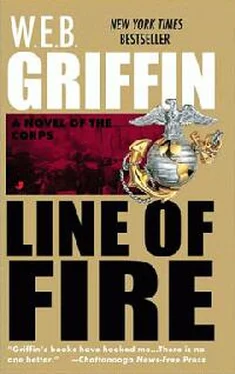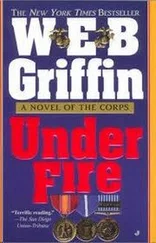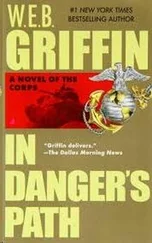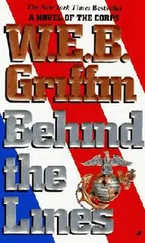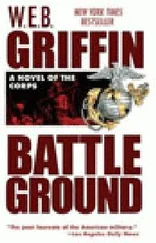W.E.B. Griffin - The Corps V - Line of Fire
Здесь есть возможность читать онлайн «W.E.B. Griffin - The Corps V - Line of Fire» весь текст электронной книги совершенно бесплатно (целиком полную версию без сокращений). В некоторых случаях можно слушать аудио, скачать через торрент в формате fb2 и присутствует краткое содержание. Жанр: prose_military, на английском языке. Описание произведения, (предисловие) а так же отзывы посетителей доступны на портале библиотеки ЛибКат.
- Название:The Corps V - Line of Fire
- Автор:
- Жанр:
- Год:неизвестен
- ISBN:нет данных
- Рейтинг книги:4 / 5. Голосов: 1
-
Избранное:Добавить в избранное
- Отзывы:
-
Ваша оценка:
- 80
- 1
- 2
- 3
- 4
- 5
The Corps V - Line of Fire: краткое содержание, описание и аннотация
Предлагаем к чтению аннотацию, описание, краткое содержание или предисловие (зависит от того, что написал сам автор книги «The Corps V - Line of Fire»). Если вы не нашли необходимую информацию о книге — напишите в комментариях, мы постараемся отыскать её.
The Corps V - Line of Fire — читать онлайн бесплатно полную книгу (весь текст) целиком
Ниже представлен текст книги, разбитый по страницам. Система сохранения места последней прочитанной страницы, позволяет с удобством читать онлайн бесплатно книгу «The Corps V - Line of Fire», без необходимости каждый раз заново искать на чём Вы остановились. Поставьте закладку, и сможете в любой момент перейти на страницу, на которой закончили чтение.
Интервал:
Закладка:
It was possible, he recalled, to navigate by using the known location of radio stations. This pilot was obviously not doing that, because there were obviously no useful radio stations operating anywhere near here.
What the pilot was doing was making a guess where he was by dead reckoning: He'd have worked that out by plotting how long he'd been flying at a particular compass heading at a particular speed.
That would work only if there were no head winds, tail winds, or winds blowing the airplane to one side or another.
How they expected to find a boat as small as a submarine this far from land was an operation he simply didn't understand.
Curiosity finally overcame his reluctance to reveal his ignorance.
A RAN sailor was standing beside him looking out the blister. "I don't see how you're going to find the submarine," George confessed to him with as much savoir faire as he could muster.
"For the last hour," the sailor answered, "she's been surfacing every fifteen minutes, long enough to send a signal... They just hold the key down for ten or fifteen seconds. You saw that round thing on top?" He gestured toward the wing above.
George nodded.
"Radio direction finding antenna. Sparks just turns until the signal from the sub is strongest and gives the pilot the heading."
"Yeah," George said. "That always works, huh?"
The sailor pointed down at the sea. There was now a submarine just sitting there. It looked even smaller, even farther down, than he expected.
The submarine was the HMAS Pelican. George knew deal about HMAS Pelican On his desk in Townsville, Commander Feldt had a book with photographs and descriptions every class of ship in the major navies of the world, as, descriptions of many individual ships, too.
Since the Pelican was in the book, he looked it up; after all he was going riding -correction, diving- in it.
It -correction, she- began life as HMS Snakefish in 1936, at the Cammell Laird Shipyard in Scotland. In 1939 she transferred to the Australian Navy and renamed Pelican.
Does the Royal Navy treat the Royal Australian Navy the way the U.S. Navy treats The U.S. Marine Corps? George wondered. As a poor relation, only giving it equipment that's no good or worn out? Probably, he decided.
According to Commander Feldt's book, HMAS Pelican had a speed on the surface of 13.5 knots and a submerged speed of 10. Elsewhere in the book George read that Japanese destroyers could make more than 30 knots. That meant that the Japanese would have a hell of an advantage if they spotted the Pelican wanted a fight. Particularly since destroyers had a bunch cannons, of all sizes, and depth charges. And the Pelican only a single four-inch cannon and a couple of machine guns.
Of course the Pelican had torpedoes, but this did not give George much reassurance. He didn't think it would be very easy to hit a destroyer while it was twisting and turning at 30 knots and simultaneously shooting its cannons and throwing depth charges at you.
The Catalina suddenly began to make a steep descent toward the surface of the ocean. George grabbed one of the aluminum fuselage members. A moment later he saw blood dripping down onto his utilities.
The Catalina straightened out for a time, but then it made a really steep turn, after which it dropped its nose again.
A moment later there was an enormous splash, and then another, and then another. They were on the surface of the ocean. He looked around for the Pelican but couldn't see it.
The crew of the Catalina opened a hatch in the side of the fuselage and tossed out two packages. In a moment these began to inflate and assume the shape of rafts.
Lieutenant McCoy, wearing utilities, scrambled through the hatch and into one of the boats. A moment later Chief Signalman Wallace, wearing his skirt and his Chief Petty Officer's cap and nothing else, dropped into the other. Then two of the other three Marine members of the replacement team, a staff sergeant named Kelly and a corporal named Godfrey, got in the rafts.
That left Sergeants Doud and Hart in the Catalina. Because of their strong backs, they'd been chosen to transfer the equipment from the Catalina to the rafts.
Before they took off, Hart told McCoy that he suspected this would be a bitch of a job. And McCoy told him he thought it would be worse than a bitch of a job. He was right. One of the radios almost went in the water. And when a swell suddenly raised one end of McCoy's raft, one of the tar-paper-wrapped weapons packages did go in.
No problem, there was a spare.
Finally everything was loaded onto the rafts, and Sergeants Doud and Hart half fell, half jumped into them.
The Catalina's hatch closed and there was a cloud of black smoke as the pilot restarted his port engine. The plane swung away from them, gunned its engines, and started its takeoff.
George felt a heavy sense that he was far removed from anything friendly. And he didn't get any relief from that when he finally spotted the submarine.
The Pelican's crew are not waving a friendly hello, he realized after a moment, but gesturing angrily for us to get our asses in gear and paddle over.
One of those thirty-knot Japanese destroyers with all those cannons and depth charges is charging this way.
Why am I not afraid?
Because this whole fucking thing is so unreal that I'm unable, to believe it. What the hell am I doing paddling a little rubber boat around in the middle of the Solomon Sea?
The Pelican was a lot farther away than it seemed. By the time the raft bumped up against her hull, he was breathing so hard it hurt. And the saltwater stung like hell on the slash in his hand he'd got in the Catalina.
The Pelican's crew threw lines down to them. These were fastened to the equipment they were taking aboard, and then the crew dragged that up to the submarine's deck. Finally, the raft paddlers crawled aboard-with considerable help from the crew.
Just before passing through a hatch into the conning tower, George took one last look around him. He was surprised to see that one of the rafts was drifting away from the Pelican.
Why're they loose? They were securely tied.
But then he saw that the other raft was loose, too.
And then there was a burst of machine-gun fire from above him.
Jesus Christ! They're shooting holes in the rafts! What the hell for?
What are we going to use to get ashore?
They're shooting holes in the rafts because they expect one of those thirty-knot Japanese destroyers, that's why they're shooting holes in them. It would take too much time to deflate them and bring them aboard.
He went inside the conning tower and down a ladder. He was almost on the main deck, thinking, Jesus, it stinks in here, when a Klaxon horn went off right by his ear.
Faintly, through the squawk of the Klaxon, he heard a loudspeaker bellow, "Dive! Dive! Dive!"
[Three]
OFFICER'S MESS, MAG-21
HENDERSON FIELD
GUADALCANAL, SOLOMON ISLANDS
0730 HOURS 5 OCTOBER 1942
The officer's mess of Marine Air Group 21 was pretty much the same as the enlisted mess. They differed mainly in location and in size. The officer's mess (a sandbag enclosure topped by an open-walled tent) was on the north side of the communal kitchen (a sandbag enclosure topped by an open-walled tent).
The enlisted mess (an open-walled enclosure topped by an open-walled tent) was about twice as large as the officer's mess, -and it was on the south side of the communal kitchen.
Lieutenant Colonel Clyde W. Dawkins, USMC, in a fresh but already sweat-soaked cotton flight suit, sat on the plank seat of what looked like a six-man picnic table. Both hands were on a mug of coffee. The remnants of his breakfast tray (a steel tray holding mostly uneaten powdered eggs, bacon, toast and marmalade) were pushed to the side.
Читать дальшеИнтервал:
Закладка:
Похожие книги на «The Corps V - Line of Fire»
Представляем Вашему вниманию похожие книги на «The Corps V - Line of Fire» списком для выбора. Мы отобрали схожую по названию и смыслу литературу в надежде предоставить читателям больше вариантов отыскать новые, интересные, ещё непрочитанные произведения.
Обсуждение, отзывы о книге «The Corps V - Line of Fire» и просто собственные мнения читателей. Оставьте ваши комментарии, напишите, что Вы думаете о произведении, его смысле или главных героях. Укажите что конкретно понравилось, а что нет, и почему Вы так считаете.
